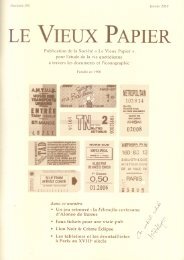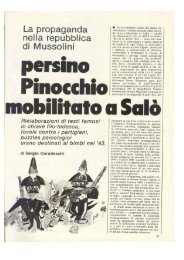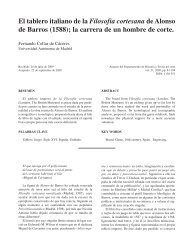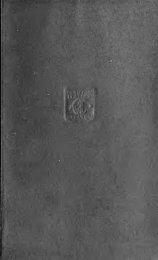Board games from the city of Vijayanagara (Hampi ... - Gioco dell'Oca.
Board games from the city of Vijayanagara (Hampi ... - Gioco dell'Oca.
Board games from the city of Vijayanagara (Hampi ... - Gioco dell'Oca.
You also want an ePaper? Increase the reach of your titles
YUMPU automatically turns print PDFs into web optimized ePapers that Google loves.
M. GRANADOS, REFLECTIONS ON THE ROLE OF BAROQUE GAMES TABLES 43<br />
<strong>Board</strong> <strong>games</strong> – and correspondingly board-game tables – were considered important<br />
enough to carry a representation <strong>of</strong> power and war. <strong>Board</strong> <strong>games</strong> like chess, morris,<br />
draughts and backgammon always have been something special, which can be explained<br />
by <strong>the</strong>ir function and symbolic meaning. The combination <strong>of</strong> chess and backgammon<br />
(trictrac) is traditional and can be found in <strong>the</strong> earliest European board-game box <strong>of</strong><br />
around 1300 kept in Aschaffenburg in <strong>the</strong> Stiftsmuseum and on hundreds <strong>of</strong> later board<br />
<strong>games</strong> and <strong>games</strong> tables. Chess as <strong>the</strong> noblest <strong>of</strong> all <strong>games</strong> is a symbol for strategy, <strong>the</strong><br />
world, and <strong>the</strong> idea <strong>of</strong> universal education. Backgammon is a tactical game as well, combined<br />
with chance, and was seen as <strong>the</strong> “luck in war” – later on as a metaphor for luck<br />
in itself. Traditionally board-game boxes also have a morris board, though in Eger this<br />
space was occupied by carvings in relief. The gameboards <strong>of</strong> Eger are ‘Kunstkammer’<br />
objects, as <strong>the</strong>y are at <strong>the</strong> same time artificalia as well as artes mechanicae, implying <strong>the</strong><br />
ma<strong>the</strong>matics <strong>of</strong> chess and draughts. In combination with <strong>the</strong> war allegories or pictures,<br />
<strong>the</strong>y also deliver a historical and political message; <strong>the</strong> same can be observed in <strong>the</strong> <strong>games</strong><br />
tables that allude to <strong>the</strong> wars against <strong>the</strong> Ottomans. All <strong>the</strong>se <strong>games</strong> tables and board<br />
<strong>games</strong> combine tactical <strong>games</strong>. Those <strong>games</strong> demand <strong>the</strong> player’s mind and intelligence,<br />
unlike pure <strong>games</strong> <strong>of</strong> chance as some card and dice <strong>games</strong>. The <strong>games</strong> <strong>of</strong> <strong>the</strong>se <strong>games</strong><br />
tables <strong>the</strong>refore are representative as <strong>the</strong>y can be seen as a pro<strong>of</strong> <strong>of</strong> <strong>the</strong> player’s intelligence<br />
and tactical abilities. So it might seem logical that all representative <strong>games</strong> tables with<br />
symbols <strong>of</strong> war use tactical <strong>games</strong>.<br />
An example in Würzburg, by Carl Maximilian Mattern and Johann Wolfgang von<br />
Auwera, proves <strong>the</strong> opposite: a gambling table <strong>of</strong> 1741 for cards or dice made out <strong>of</strong><br />
precious materials and with symbols <strong>of</strong> war (plate 4). Here, a <strong>games</strong> table for <strong>games</strong> <strong>of</strong><br />
chance is made <strong>of</strong> very precious materials, and thus becomes a representative piece <strong>of</strong> furniture.<br />
On <strong>the</strong> tabletop, we find symbols <strong>of</strong> war again, this time <strong>of</strong> a more general character.<br />
The tabletop is rectangular with flat corners. On each side <strong>the</strong>re is an oval concave<br />
money tray, <strong>the</strong> typical feature <strong>of</strong> a gambling table. The top is made out <strong>of</strong> glass with<br />
under-glass paintings. In <strong>the</strong> middle <strong>of</strong> each side we find a cartouche <strong>of</strong> leaves and<br />
rocaille ornaments, inside <strong>the</strong> cartouches male and female busts, <strong>the</strong> attributes identify<br />
<strong>the</strong>m as <strong>the</strong> four seasons. Mars and Bellona are sitting on <strong>the</strong> cartouches <strong>of</strong> <strong>the</strong> longer<br />
sides, and on <strong>the</strong> shorter sides we find war trophies, like banners, drums and trumpets,<br />
helmets, armors and various kinds <strong>of</strong> lances.The <strong>games</strong> table was made for <strong>the</strong> cabinet<br />
<strong>of</strong> <strong>the</strong> prince bishop <strong>of</strong> Bamberg and Würzburg, Friedrich Carl von Schönborn. Carl<br />
Maximilian Mattern got <strong>the</strong> commission for four <strong>games</strong> tables in <strong>the</strong> year 1741, and a<br />
bill <strong>of</strong> 1742 for <strong>the</strong> four <strong>games</strong> tables has been preserved. The second <strong>games</strong> table, which<br />
is lost, was a present <strong>from</strong> <strong>the</strong> prince-bishop Friedrich Carl von Schönborn to Emperor<br />
Charles VII Albrecht in Frankfurt in <strong>the</strong> year 1742. It was completely identical with <strong>the</strong><br />
<strong>games</strong> table in Würzburg, but it is unknown whe<strong>the</strong>r <strong>the</strong> under-glass painting was <strong>the</strong><br />
same. The o<strong>the</strong>r two <strong>games</strong> tables <strong>of</strong> <strong>the</strong> commission and bill probably were less precious,<br />
as <strong>the</strong>y are not specifically described.<br />
In this case, a game <strong>of</strong> chance was considered representative enough to be combined<br />
with precious materials and war allegories. Card <strong>games</strong> and gambling were one <strong>of</strong> <strong>the</strong><br />
major activities at courts <strong>of</strong> <strong>the</strong> time, but still <strong>the</strong>re always has been a moral objection







